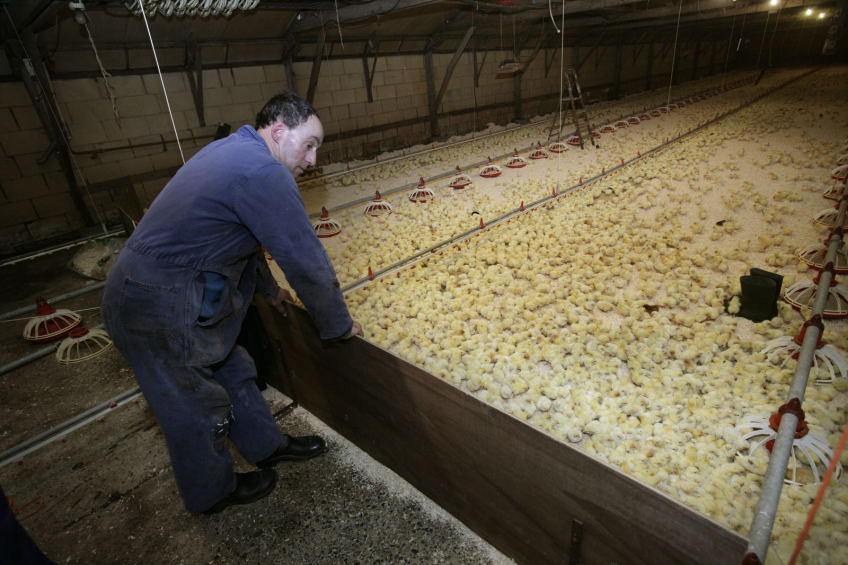10 tips for successful chick placing

Broiler chicks undergo a stressful time from the moment of hatch up to their placement on the farm. That final moment of putting them in the house, also demands special skills of the placement team. Knowledge is just as important.
In a specialised and fast paced production environment like the poultry industry, teams are very necessary, especially in a process where quite a number of people are required to perform their important segment of the overall operation. This is carried out with the utmost efficiency, correct timing and not forgetting their dedication to the welfare of the day old chicks.
This is a critical aspect in the production chain and ensures quality performances house after house, site after site. Here consistency is the key. With the correct production planning, one of these teams will be able to place 2 to 3 houses daily, each of 40,000 chicks. This depends on, how long after placing the chicks in the brooding area, are they going to spend there with the chicks. This of course depends on:
- the chick quality,
- transportation time
- flock age: chicks from young flocks requiring more attention. External weather conditions matter to a certain extent.
Every member needs to be a proven stockman/stockwoman. Women in general, tend to have the maternal instinct and show more signs of care and attention to the well-being of the young chicks than their male counterparts. However, the key is to select the best consistent performers who have a desire to do this specific work and also to keep them motivated by their team leader and site managers.

Preparing for chicks arrival
It is impossible to do the best possible chick placement if you do not know what you are going to receive, at least several days in advance. The site manager should have the initial house set up in place, this should be done in consultation with the placing team’s leader. The brooding area can be set up as to the best needs of chicks from flocks of a specific age and day old weights.

Basic information the team needs to know to achieve their part in a successful placement:
- Did anything happen during the incubation cycle?
- For example was egg pre-heating carried out?
- Was the setter and hatcher humidity graphs as per stipulations?
- Were all the nozzles functioning correctly?
- Was the hatch ‘early’ or ‘late’?
- Were any hot or cold spots found?
- What was the hatch window period?

What must the team be looking for?
- Flock age
- Expected body weight
- Chick CV (uniformity)
- First-grade chicks.
- The eggs must be from 1 flock
- Eggs must not be more than 4 days difference in age
- Any underweight eggs must be removed before setting
- Each member of the team must have the confidence to speak out if they are seeing something that does not appear 100%. Whether it is something concerning chick quality, eyes, beaks, legs, navels, vents, cold chicks, soft chicks, lethargic chicks. Are they stressed?
- What is the feather development like on the primaries and secondaries?Take into account if it is a fast or slow feathering breed. Many chicks from a slow feathering breed showing a lot of feather development would suggest a large hatch window which can have its problems.
- Always look out for these things as well as red hocks. They do not just happen, they are caused.

Make necessary changes
Today the hatchery has to be more involved than ever before with its customers, whether independent or own company sites. With today’s communications technology the hatchery should be able to video some footage of the chicks in their plastic crates or cardboard boxes, prior to loading, giving the placing and the site managers, as well as the rest of the team, a visual of what they can expect to receive. The chick CV should be sent via ‘email’ to show the percentage of chicks within 5% and 10% of the mean as well as the average weight and flock age (breed if necessary). Until arrival time the team can ponder over these issues, they can conjure up in their minds some positive thoughts of any changes that may need to be done and have them
carried out in the chicken house before chick arrival time. Namely:
- increase house temperature by 1-2°C if the chicks are a younger flock (24-29 weeks);
- lower nipple lines to accommodate chick height;
- add supplementary water fonts, if being used for the first 5-6 days, place a little lower in the bedding
- bedding should preferably be white wood shavings 1.5 cm wide and 4 cm long usually with a curl at one end and to a depth of 10 cm.

Increase willingness
All team members should become involved so that they can learn and add to the decision making process. If they are drawn in to this type of interaction, it will increase their willingness to perform better which results in a better work situation, a camaraderie as it were. This will depend on, to a large extent, the team leader who needs to have the correct attitude to involve everyone as well as the knowledge to be a leader.
A recent trial revealed that broilers grown on white wood shavings resulted in a higher percentage of breast meat as opposed to those on other litter types. In addition, the shavings were dust free as well as being treated to kill fungi and bacteria. Litter was drier and floor conditions better, resulting in better weights, lower mortality and better FCR. Apart from soft white wood shavings, also pea (ground) nut kernels, sunflower seed husks, and in an emergency shredded newspaper for the first few days are also possible for litter. Red woods in general are harder woods and do not absorb the moisture as well as white wood shavings.

Adjust computer settings
The placing team leader and the site manager now know what chicks they will receive and can fine tune the computer settings if any adjustments are required for heat, ventilation, humidity, correct light intensity (brightness is a must for the chicks for the first seven days). The amount of space required for the first 3-4 days in the brooding area should be +- 65 chicks per m2. With infrared thermometers the temperature should be checked to be at an even 32°C across the whole brooding area on top of the white wood shavings and chick feed paper. Air temperature should be 3-34°C and humidity 60-65%, after 3-5 days 50-60%. When entering the house first thing in the morning, if it is 70% RH then the minimum ventilation setting is too low. The team leader besides having an IR (infrared) thermometer also needs to have a hand held unit which gives the following information:
- % RH
- air speed across the house expressed in six units of measurement
- temperature in °C or F
- wind chill
- dew Point
- heat index
- Site manager and stockmen should also have, and know how to operate this equipment.

Correct floor temperature
Placement of additional water in chick fonts, as mentioned earlier, is a must and can be added at the rate of 1/200 chicks for the first 5-6 days or until after the chicks have become used to their surroundings, after their first enlargement of the brooding area. If the floor temperature was 28°C before the arrival of the chicks, it would be advisable not to place them until the temperature has reached 32°C. The team know that the cooler floor temperatures can result in the birds being 60 grams lighter at lifting. When moving out for the first space enlargement ensure that the floor temperature is also 32°C. If not, some will lose temperature (the smaller ones) and this will show up in unevenness at a later stage. A first move should now allow 45-50 chicks per m2. This is a guide line, if you see they need more space, then give it to them.

Target weight in time
Undoubtedly, the most critical initial goal to achieve, and this sets the target for the placing team, is to enable the chicks to get off to the best possible start in order to achieve the 7 day goal weight of 180+ g.
To achieve this, everything has to be correct. Although the team are only involved for a few hours to help in getting everything off to a good start, the site/farm manager and his staff have also to be top, in their own right, in order to keep the initial momentum going. The team will only leave when they are satisfied that everything is as they want it to be, this will normally be anything from two to three hours or more if they pick up anything that needs changed.

Easy off-loading
The placing team numbers depend on: the number of chicks that are to be placed, in the case of our example it is 40,000 or 400 of the latest plastic crates. These allow very good air movement through to the chicks and around the stacks inside the controlled environment delivery vehicle. This is equipped with a rear tail gate for ease of off-loading the trolleys at the entrance of the house, usually at the front. Trolleys will be pushed inside without delay and moved to the edge of the brooding area.
In cold climates there may be a pre-heated reception room which will prevent cold air entering into the brooding area. Once all the trolleys have been pushed in and doors closed, the chicks can be taken into the brooding area. Usually 8 people will be adequate, 6 for placing and 2 for weight checking, also there will be the placing and site manager and his houseman who will help in removing the crates when empty.

No tipping and talking
50% of the brooding floor area has been covered with chick feed paper and chick starter crumbles at the rate of 75 g/chick, spread out. The placing team should not ‘tip’ the chicks out of the crates. This is completely incorrect and can start many chicks off negatively, due to the sudden shock or physical disorientation. Preferably they should be placed by hand, holding the 2 hands together and gathering up 5-6 at a time and setting them on the shavings/feed. Why this way? You have contact with the chicks, feel their ‘feel’. It’s like stockmanship, you get a feeling for day old chicks and you want to pamper them, to see them grow well, not to hurt or harm them.
When ‘placing’ the chicks, don’t talk, as they will follow you and quite a number can be stood on. Do the placing in a line across the width of the brooding area and work backwards. Initially they will have been stacked 5 up in this configuration after the trolleys were wheeled to the side of the brooding area.
In 7 days, when the sample weighing has been completed on 900 chicks (2.25%), 300 each from the front, middle and back, in a batch sample to get the average, you will see if the 200 grams target has been reached. Individual weights should also be recorded on 150 of each of these 3 samples, to check for uniformity. Having achieved the first weight goal of 180+ gram at 7 days and a mean variation of 5%, the next challenge for the site manager is to ensure that the targets are adhered to weekly.















